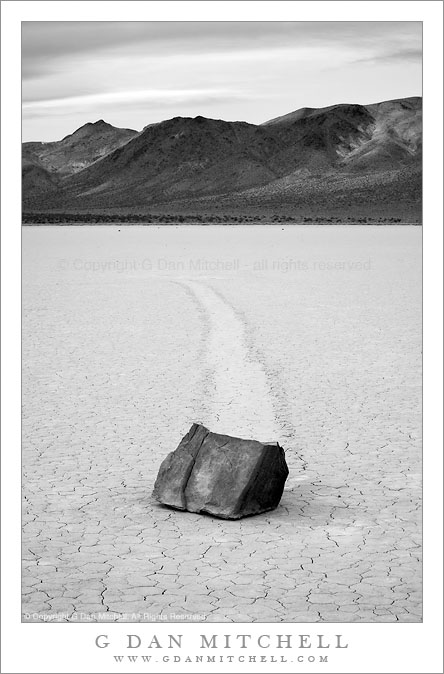Sliding Rock, Cloudy Morning – Racetrack Playa. Death Valley National Park, California. March 29, 2010. © Copyright G Dan Mitchell – all rights reserved.
Black and white photograph of a “sliding rock” on a cloudy morning at the Racetrack Playa, Death Valley National Park, California.
The weather gods were not on my side during my visit to the Racetrack Playa in Death Valley near the end of March. My plan was to shoot sunset and sunrise, and in between to do night photography. As I drove out there on the terrible washboard gravel road my hopes were high – I saw some interesting looking clouds that looked like they might even form into lenticular clouds. When I arrived I shot a bit in decent light at the “Grandstand” feature near the north end of the playa.
Unfortunately, the good light was short-lived. Before I left the Grandstand a high, thin back of clouds spread across the sky. It stayed in the evening (tantalizing me with some bits of clear sky far to the west), blocked the full moon all night, and was still there when I wandered out onto the playa in the morning to do some early shots. It never did really clear, and I came back from the playa with far fewer good images than I expected. (I shouldn’t have been surprised. I’ve had uniform great luck with lighting on every previous visit, so I was probably due for less than great light.)
In order to make this photograph work I did quite a bit of post-processing, some of which I anticipated when I made the exposure. First of all, I realized that getting everything from the very close rock to the distant ridge in focus would be a problem. So I made three exposures, “focus bracketing” them with one focus on the far ridge, one focused on the rock, and one focused in between. I made a blend of the three exposures in post, keeping the most focused portions of each.
Because the light and colors were fairly flat I decided to go with a black and white interpretation. The conversion was fairly straightforward, but here I also decided to indulge in a bit of post-processing. I duplicated the background layer, turned it into and “overlay,” and added some Gaussian blur. With a bit of dodging, burning, and work with curves, the image ended up where I imagined it would.
This photograph is not in the public domain and may not be used on websites, blogs, or in other media without advance permission from G Dan Mitchell.
G Dan Mitchell Photography | Twitter | Friendfeed | Facebook | Facebook Fan Page | Email
Technical Data:
Canon EOS 5D Mark II
Canon EF 24-105mm f/4 L IS USM at 80mm
ISO 200, f/16, 1/10 second
keywords: sliding, moving, gliding, rock, stone, racetrack, race, track, playa, cracked, mud, earth, ground, cloudy, mountain, hill, barren, desert, rugged, track, trail, black and white, monochrome, death valley, national, park, california, usa, north america, landscape, nature, travel, scenic, stock
Discover more from G Dan Mitchell Photography
Subscribe to get the latest posts sent to your email.


Thanks, Dan. I learned something new today!
Focus bracketing is a way to get very deep DOF, and is especially useful when the foreground and background are far apart and both need to be in focus. It is especially useful when using longer focal lengths. Basically the idea is to make several exposures focused at different distances into the scene and to then combine them in post, keeping the sharpest portions of each. It works really with with a scene like this one where the main subject is essentially a plane tilted away from the camera.
Dan
I have never heard of the term “focus bracketing”, but then there are a lot of concepts and terms I’m not aware of!
Whatever technique you used, it works, and looks great!
I guess if some day I have to use this technique, I better brush up on on my Photoshop skills!
Wonderful read, I love to hear what photographers are thinking while making these beautiful images. I wonder why the focus bracketing was used? Couldn’t an f/22 or other small aperture keep everything in focus? I’m guessing at 80mm that the closest ground in frame is not too close, so everything from that (maybe 10-15ft away?) to infinity could be sharp? I’d love to hear more of your thinking about using that method. Thanks for sharing!
Hi Erik:
Thanks for writing! There would have been two problems with using a smaller aperture. First, in this case even f/22 would not have gotten sufficient DOF for what I had in mind. Also, because I’m always considering the possibility of printing at 24″ x 36″ (or possibly even larger) I am concerned with – among other things – maximizing sharpness in an image like this. Even if the f/22 aperture had worked “according to the DOF charts,” it would not be sharp enough for that size of enlargement. Secondly, there is the issue of diffraction blur. On a full frame DSLR I feel (based on my testing) that I can stop down to f/16 without any appreciable lost in sharpness to diffraction, but beyond that any increase in DOF is offset by the decreased maximum sharpness due to the effects of diffraction. (On a cropped sensor camera you have to be concerned about this if you stop down past about f/8!)
Dan